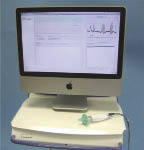Up to more than one-third of the 600,000 premature babies born in the US each year have feeding problems because their brains struggle to coordinate sucking, swallowing, and breathing. Infants can spend months in the hospital with tubes taped to their faces or wearing masks to help them breathe.

KC BioMediX, a start-up medical device company, developed a product called the NTrainer System to help these infants learn to oral feed and increase their chances for a healthy life. The device is a computerized pacifier that makes the tip pulse with gentle bursts of air. Hospital staff can use the device to get a more accurate assessment of a baby’s feeding ability and begin therapy to help the baby learn to feed.
At the onset of the project, Daryl Farr and Kenny Aron, KC BioMediX researchers, began the design process using a custom embedded software product and worked with a third-party company to commercialize the product. When it became clear that development costs were too high, they decided to tackle the project in-house.

Medical device developers used
hardware and software from National
Instruments to create the NTrainer
System in four weeks’ time.
In three weeks’ time, the team used LabVIEW graphical development software and CompactRIO hardware to create a proof of concept demonstrating the ability of the hardware to replace the custom embedded software. They developed the software architecture using LabVIEW Real-Time, LabVIEW FPGA, and LabVIEW Statechart modules.
For the first round of commercial devices, they deployed the systems using CompactRIO. For high-volume deployment, they used NI Single-Board RIO to create a more cost-effective device while maintaining their software development investment. As a result, the KC BioMediX team reduced their development costs by $250,000 and slashed development time from four months to four weeks while avoiding the necessity of developing custom control software and drivers.
National Instruments
www.ni.com
::Design World::




